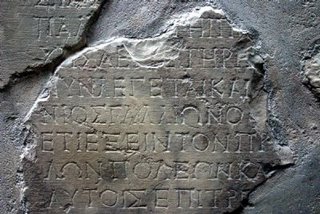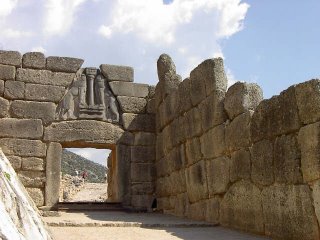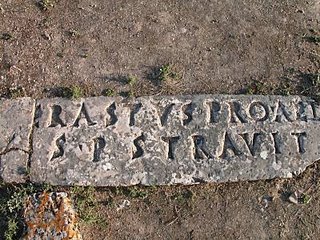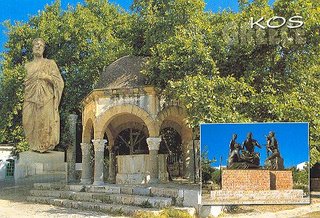Thursday, June 22, 2006
A Day at Delphi
Hello From Athens,
Everyone is fine and doing well.
Today we visited the Ancient Site of Delphi. It is a beautiful site and the favorite of many people. I think that it is my favorite site in Greece. You are high up in the mountains but you have a commanding view of the sea below. Ancient Greeks climbed the hills to worship Apollo and Athena and seek guidance from the oracle at the Temple of Apollo. They also gathered for the Pythian Games, which is one of the four Pan-Hellenic games. There were also poetry and music contests and meetings where leaders of Ancient Greek City-States could talk politics over and come to decisions.
We made our way to the Roman Forum and then up the Sacred Way. Along the Sacred way there were once statues to honor donors, athletes, and musicians. These statues lined the Sacred Way so everyone would remember what they had achieved. Also along the Sacred Way were several treasuries of cities housing their gifts to the god Apollo. For example at the prows of the warships were lined up to commemorate the Athenian victory over the Persians. The retaining walls are built of polygonal construction to help them survive earthquake attacks.
Many of these stones are covered with inscriptions, many of these inscriptions record masters freeing their slaves. At the heart of the site is the Temple of Apollo which has a large altar in front. Adjacent to the Temple stood a bronze tripod of Platea which is made of intertwined bronze snakes. This tripod was carried off by Constantine the Great and was put in the center of the hippodrome. A part of the tripod is located at the hippodrome in Istanbul what is left of it we saw earlier on the trip
The Temple of Apollo is of Doric style and it is built over 2 fault lines which has recently been studied by geologist who have determined that a form of methane gas would have been released from these fissures which would have had a hallucinogenic effect on the priestess who would sit on a tripod over the opening and speak in a “language” only the priest could understand. People would wait in line on the seventh day of the month and would be chosen by lot to choose the order. They would tell the priest the question and he would rely it to the priestess and later return with her answer. An answer he would interpret for the one waiting. Sometimes the answers were straight forward and often the person would get the answer they desired. But sometimes the answers were veiled and opened to interpretation. Under the temple there are still passages which people climb in. The oracle would go into the basement of the temple to answer the questions.
Up above the Temple is a nice theater which was used for dramas and plays. Up even further is a stadium with stone seats and nice starting gates.
Before visiting the site we went to the museum which has several amazing objects all found during the excavations at Delphi. Delphi was home to the Pythian Games which was one of the Panhellenic Games. These games took place every four years in honor of Apollo, the god of wisdom. The temple to Apollo was home to oracle of Delphi. A priestess of the temple functioned as the oracle. People would come and ask questions of the oracle on special days. She would sit in the temple on a tripod over a crack where vapors would rise up and have a hallucinogenic effect on her and she would speak in a "priestly language" and predict the future often in vague ways.
Recently geologists and archaeologists have worked together and discovered that a fault line runs under the temple and that have hallucinogenic properties.As one of the panhellenic games as well as a home to an oracle Delphi was the most important religious site on the mainland. Several treasuries and monuments were built as each city tried to out do the other. Many of these offerings to Apollo were lost on the site and have now been recovered by archaeologists.In the museum some of the most important objects include a large Sphinx.
As I look at it I was reminded of Oedipus and the riddle of the sphinx. The Siphinian Treasury which dates to 525BC is one of the oldest Ionic marble buildings on the mainland. The pediments of the building are well-preserved. One side with the Judgment of Paris and the other with the combat of combat before Troy with the assembly of the gods. This has the name of the artist on one of the shields.The Treasure Room has amazing objects such as parts of the chryselephantine (made from ivory and gold) statues of Apollo and Artemis. Also the remains of a large statue of a bull made of silver.One of the most famous items in the museum is the Charioteer which is an original bronze which sections of the horse and chariot. This was made to honor the victor of chariot 478 or 474 in Pythian games.Also there is a famous marble statue of Antinoos. He was a famous companion of Emperor Hadrian who died by drowning in the Nile during a trip their with the emperor.Also the museum has an inscription which has musical notation on it. This is one the earliest indications of musical notation in Ancient Greece it dates to the 3rd century BC.
My favorite item in the museum was the Gallio inscription. This is an inscription that I have been talking about for many years. It makes reference to Gallio who is mentioned in Acts 18. Gallio is proconsul of Acacia. The emperor Nero wrote a letter honoring him which is preserved in this inscription. Paul was taken before Gallio by the Jews of Corinth. Here Gallio determined not to get involved in what he called Jewish disputes. Since a proconsulship only lasted one year and since Paul was only in Corinth for eighteen months this inscription establishes a benchmark in the chronology in Paul’s life and missionary journeys. So this is an important piece of evidence for New Testament studies.
Tomorrow we fly out of Athens to New York and then on to Atlanta.
I have to fly out earlier than the group go through Milan and then to DC and then meet them again in Atlanta.
John Wineland
Athens, Greece
Wednesday, June 21, 2006
Corinth, Acro-Corinth and Mycenae
Greetings from Athens again!!!
We are fine and doing well. We enjoyed our trip today.
We visited the site of Corinth. Corinth importance in ancient times was due to its location near the isthmus with mainland Greece. It had 2 important harbors which it controlled Cenchrea and Lechaion. A great deal of trade traveled through the city. So it control important land and sea routes. This is a site with a long occupation, dating from the Bronze Age like Mycenae.
It flourished from the 7th to the 4th centuries BC. It was destroyed by the Roman General Mummius in 144BC. The Romans punished Corinth because they rebelled against Roman authrity. The leveled every building in the town except for the Temple to Apollo.
The town was restructured as a Roman city and it was this town that Paul visited in the first century. He founded a church at the city and wrote 2 letters to the Christians there. The most impressive structure on the site is the Temple to Apollo it has 7 Doric columns still standing and it is one of the earliest temples in Greece.
We also saw the Bema of the city which is the likely location of Gallio's address as recorded in Acts 18 when Paul is taken before him and charged with crimes against the Jews of the city.
The AcroCorinth rising above the city was the home to the Temple to Aprodite. Her priestess served as Temple prostitutes in the city. The mobile population and this temple led to many of the problems in the Corinth church. The main road to Lechaion is well preserved and has a large fountain, several shops and even public toliet on either side of the street.
The museum has many important statues and frescos. It also has an inscription from a 5th century synagogue in the city. Corinth had an Askelpion healing center and some of the votive offerings of models of body parts offered to god for healing are on display.
The odeon and theater of the site were closed. But a few of us found a way to enter the theater area so we could see the famous Erastus inscription which mentions that Erastus a leader in the city paid for a pavement on the east side of the theater. Erastus is mentioned as a Christian convert and friend of Paul in Romans 16.
We then drove up to the bottom of the top of Acro-Corinth. Then several of us hiked to the top. This quite a hike but we were rewarded with an amazing view of the city and harbors below. This was the site of the Aprodite temple and later fortresses from the Frankish, Ottoman, and Venetian periods.
We ate lunch near the canal which was cut through the Isthmus in the late 19th century.
The we drove to Mycenae the site which provides the name for the Mycenean Civilization. The city flourished during the Bronze Age esp from 1600 to 1100 BC. Here is a good website with information about and images of Mycenae http://wms.erudition.net/mycenae.html
This site has an amazing Lion's Gate and a tholos or beehive tomb nearby. This site was excavated by Heinrich Schliemann in the 19th century who found rich burials in the Grave Circle A with several gold objects. On the citadel of the site is the Megaron which was the audience hall/palace of the King. We also visited the well preserved Tholos or beehive tomb called the Treasury of Atreus. It was a burial place for the elites of the Bronze age 14th cent. BC. With a large dromos or entranceway and the tomb itself was flanked by large columns on either side. This style of tomb is constructed of stone in a beehive shape and then earth is piled on top. The dromos is dug out each time a new burial is needed.
Tomorrow we head out for our last day of touring. We are ending with a beautiful site called Delphi, home to the oracle.
John Wineland
Athens, Greece
Tuesday, June 20, 2006
Hello From Athens
Greetings
We are now in Athens. We are all safe and sound after our cruise across the Aegean.
We toured the small but amazing museum in Santorini. It has the remains of Akrotiri the Pompei of the Aegean. While Pompei dates to the first century AD, Akrotiri dates to about 1650 BC. There are amzing frescos one with monkeys!! Also a chair (they were able to pour plaster of paris into the holes in the volcanic ash and they were able to recover the outline of chairs and beds etc. They have many everyday objects as well as art.
We then were able to have an hour or so to enjoy the fantastic view and then we were off to the ship. It was a larger ferry which hauled cars and motorcycles underneath. We travel to out hotel and then met in the lobby for a walk to the National Archaelogical Museum. It has amazing finds.
It has material from all over Greece including the islands. There are many fine examples of Greek pottery from all the periods from Geometric on to Black and Red figures pottery. There are many fine bronze statues also. Most which were recovers from the sea. The large bronze of Zeus is one of the finest pieces in the museum. The museum also hs the Mycenaen materials from the tombs of Mycenae. Schliemann found gold desk masks and fine gold objects. Also on display on the second floor are some of the frescos from ancient Thera.
After our visit to the museum we had dinner at the hotel.
Tomorrow we visit Corinth and Mycenae.
John Wineland
Athens
Monday, June 19, 2006
Hello From Ancient Thera, Santorini
| Greetings, Everyone is fine and doing well. We have enjoyed our day on the island of Santorini. We left this morning from Heraklion, Crete. We traveled on a Cat 4 super fast boat. The boat moves so quickly that it is entirely enclosed, much like an airplane inside. Upon arrival we were greeted by our bus and guide. We then had a nice tour of the island, so many people were able to swin the Aegean. We also drove to the North end of the island for a spectular view of the island. A volcano exploded and formed a calderia about 1650 BC. When this volcano blew up the island exploded and the entire middle of the island blew out. This destroyed the Minoan settlements on the island and created problems for them elsewhere. Some people beleive that this explosion is the history event to which Plato refers when he speaks of Atlantis. Of course this is highly speculative. We were scheduled to visit the ruins of Akrotiri but unfortnately the site is now closed because of an accident earlier in the year when part of the protective roof collasped on the 2 tourists and 1 guide. Akrotiri has been called the Pompeii of the Aegean. I guess we have to return later to this beautiful island to see the site. However tomorrow we visit the museum in town and it has many of the most sceptacular finds from the site. This is the second most desirable vacation spot in the world just behind Bali accord to our guide today. Tomorrow after visiting the museum we will take a boat ride to Athens for the last days of our tour. John Wineland Santorini, Greece |
Sunday, June 18, 2006
Greetings from Heraklion
Hello,
Everyone is fine and doing well. We visited the Palace of the Legendary Minos at Knossos. This was excavated in the early 20th century by Sir Arthur Evans. There is a large palace which has been reconstructed which has frescos and throne rooms. We saw the large storage jars (Kraters) which held the grain and oil for the palace. It is a wonderful site. Part of it was shut down for restorations.
Today's weather was probably the warmest we have faced but it was not too bad.
After a bus tour of the city where we saw the Venetian walls and gates, we ate lunch in the heart of the city.
The we had nice tour of fablous Archaeology Museum of Heraklion. We saw the famous Phaistos Disk, Linear A, and B tablets, frescoes from Knossos and the fablous gold ring of King Minos.
Tomorrow we sail to Santorini (Thira) and visit more Minonan ruins.
John Wineland
Heraklion, Crete Greece
Saturday, June 17, 2006
Greetings from the island of Crete
Hello Everyone,
We are all fine and doing well. We are on the island of Crete home of the Minoans.
We had a busy day today. We left Turkey and traveled by boat to the island of Kos. We had a nice time visiting the island which had a fine castle and shops and resturants. The island has a fine castle built by the Hospitallers. It also has the Plane tree of Hippocrates the famous early doctor and author of the Hippocratic oath. The locals believe that he planted the huge tree.
The Apostle Paul visited this site on his second missionary journey. Acts 21
We then went to the airport and caught our flight to the island of Rhodes and then another flight to Crete. After a late dinner we are enjoying our nice hotel in Crete.
Tomorrow we will visit the ruins of the Minoan palace at Knossos and the museum.
John Wineland
Heraklion, Crete, Greece
Friday, June 16, 2006
Greetings From Bodrum
Hello
Everyone is doıng well and having a great time on our tour.
We left the area of Ephesus this morning and drowe to the site of Afrodisia. This ıs a wonderful site with a large theater and a temple to Aprodite. The site has the largest and best preserved stadium in the ancient world. We had a footrace between three of the students. So we got a real sense of what an ancient race would have been like. There was a large tetrapylon on the site too. Thıs marked the intersection of two important roads of the city.
After visiting the site we went to the nice museum. It has much of the material found on the site. A school of sculpture was established at the site so we saw many fine examples of sculpture ın the museum. There also was a nice dısplay on the way ancıent coins were made.
After our visit to the site we had a nice lunch and drove on to Bodrum. Bodrum was called Halicarnasus in ancient times. It was the birthplace of Herodotus the Father of History. It ıs also home to the one of the seven wonders of the ancient world. The mauselum of Halicarnassus.
We visited the Crusader period castle located on what was an islan. It now is attached to the mainland by a causeway. The city was captured by the Crusaders during in the First Crusade. Later the Turks captured the city. Finally the Knights of St. John the Hospitallers captured the castle in 1305. The city came under the control Sulimann the Magnificant in 1522.
It is a spectacular castle and housed inside the castle is an extensive museum of underwater archaeology. They have the remains of the earliest boat wreck ever found dating to the Bronze Age, 16th century BC and 13th BC.
They had an amazing dısplay of amphora and anchors. Everyone enjoyed our visit to the castle. Just outside the castle was a nice statue of Herodotus.
Tomorrow we leave Turkey. We will sail from Bodrum to Kos and from there fly to Crete via Rhodes.
John Wineland
Bodrum, Turkey
Everyone is doıng well and having a great time on our tour.
We left the area of Ephesus this morning and drowe to the site of Afrodisia. This ıs a wonderful site with a large theater and a temple to Aprodite. The site has the largest and best preserved stadium in the ancient world. We had a footrace between three of the students. So we got a real sense of what an ancient race would have been like. There was a large tetrapylon on the site too. Thıs marked the intersection of two important roads of the city.
After visiting the site we went to the nice museum. It has much of the material found on the site. A school of sculpture was established at the site so we saw many fine examples of sculpture ın the museum. There also was a nice dısplay on the way ancıent coins were made.
After our visit to the site we had a nice lunch and drove on to Bodrum. Bodrum was called Halicarnasus in ancient times. It was the birthplace of Herodotus the Father of History. It ıs also home to the one of the seven wonders of the ancient world. The mauselum of Halicarnassus.
We visited the Crusader period castle located on what was an islan. It now is attached to the mainland by a causeway. The city was captured by the Crusaders during in the First Crusade. Later the Turks captured the city. Finally the Knights of St. John the Hospitallers captured the castle in 1305. The city came under the control Sulimann the Magnificant in 1522.
It is a spectacular castle and housed inside the castle is an extensive museum of underwater archaeology. They have the remains of the earliest boat wreck ever found dating to the Bronze Age, 16th century BC and 13th BC.
They had an amazing dısplay of amphora and anchors. Everyone enjoyed our visit to the castle. Just outside the castle was a nice statue of Herodotus.
Tomorrow we leave Turkey. We will sail from Bodrum to Kos and from there fly to Crete via Rhodes.
John Wineland
Bodrum, Turkey











